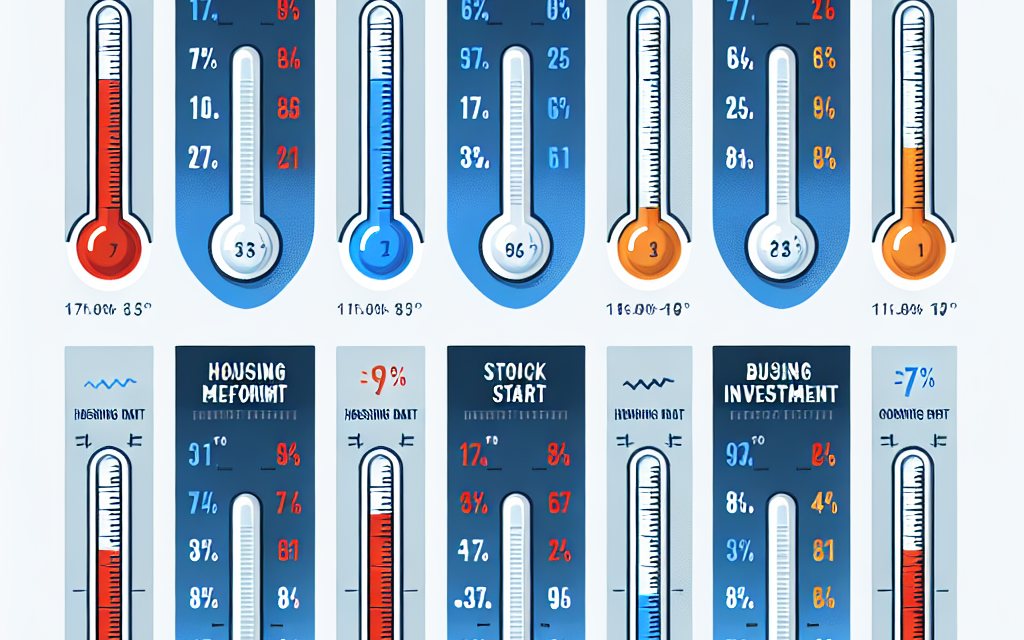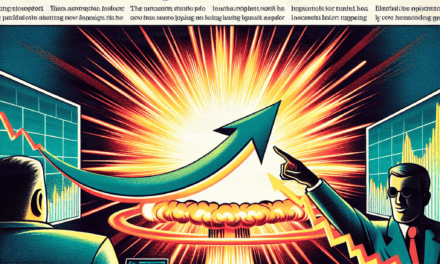“Unveiling the Chill: Nine Economic Indicators That Have Lost Their Heat.”
Introduction
In recent years, various economic indicators that once served as reliable barometers of economic health have shown signs of diminishing relevance. As the global economy evolves, traditional metrics may no longer accurately reflect current market dynamics or consumer behavior. This shift prompts a reevaluation of which indicators truly capture the complexities of modern economies. This introduction explores nine economic indicators that have lost their heat, examining the reasons behind their decline and the implications for policymakers, investors, and analysts navigating today’s economic landscape.
Inflation Rates: A Decline in Consumer Price Growth
In recent years, inflation rates have been a focal point of economic discussions, capturing the attention of policymakers, businesses, and consumers alike. However, as we delve into the current economic landscape, it becomes evident that the once alarming inflation rates have begun to show signs of decline. This shift in consumer price growth is significant, as it reflects broader trends in the economy and influences various sectors.
To understand the implications of declining inflation rates, it is essential to consider the factors contributing to this phenomenon. Initially, the surge in inflation that characterized the post-pandemic recovery was driven by a combination of supply chain disruptions, increased consumer demand, and expansive monetary policies. As economies reopened, pent-up demand collided with constrained supply, leading to price surges across numerous sectors. However, as supply chains have gradually stabilized and production capacities have increased, the pressure on prices has started to ease.
Moreover, central banks have responded to rising inflation by adjusting their monetary policies. Interest rate hikes have become a common tool employed to temper inflationary pressures. As borrowing costs rise, consumer spending tends to slow, which in turn can lead to a deceleration in price growth. This dynamic illustrates the delicate balance that central banks must maintain; while they aim to control inflation, they must also be cautious not to stifle economic growth. The recent adjustments in interest rates have begun to yield results, as evidenced by the gradual decline in inflation rates.
Additionally, the labor market has played a crucial role in shaping inflation trends. Initially, labor shortages contributed to wage increases, which in turn fueled consumer price growth. However, as the labor market has started to stabilize, with increased participation rates and a gradual easing of labor shortages, wage growth has moderated. This moderation in wage increases is significant, as it reduces the upward pressure on prices, further contributing to the decline in inflation rates.
Furthermore, consumer sentiment has shifted in response to changing economic conditions. As inflation rates have begun to decline, consumers may feel more confident in their purchasing power, leading to a more stable demand environment. This shift in sentiment can create a feedback loop, where declining inflation fosters increased consumer confidence, which in turn supports economic growth without reigniting inflationary pressures.
It is also important to consider the global context when analyzing inflation trends. Many economies around the world are experiencing similar patterns, with inflation rates declining as supply chains recover and demand stabilizes. This global alignment can create a more synchronized economic environment, where countries can benefit from shared stability in prices and growth.
In conclusion, the decline in inflation rates marks a significant shift in the economic landscape. As consumer price growth slows, it reflects a complex interplay of factors, including stabilized supply chains, adjusted monetary policies, moderated wage growth, and shifting consumer sentiment. While the journey toward economic stability is ongoing, the current trends suggest a more balanced approach to inflation management. As we move forward, it will be crucial for policymakers and stakeholders to remain vigilant, ensuring that the lessons learned from this period of volatility inform future strategies for sustainable economic growth.
Unemployment Trends: Shifts in Job Market Dynamics
In recent years, the landscape of the job market has undergone significant transformations, leading to shifts in unemployment trends that warrant careful examination. Traditionally, unemployment rates have served as a primary indicator of economic health, reflecting the balance between job seekers and available positions. However, as the dynamics of the labor market evolve, the reliability of this metric has come into question. One of the most notable changes is the rise of gig and freelance work, which has introduced a level of flexibility that traditional employment models do not capture. Consequently, many individuals who engage in these non-traditional roles may not be reflected in standard unemployment statistics, thereby skewing perceptions of job availability and economic stability.
Moreover, the impact of technological advancements cannot be overlooked. Automation and artificial intelligence have revolutionized various industries, leading to the displacement of certain job categories while simultaneously creating new opportunities in others. This dual effect complicates the interpretation of unemployment figures, as workers may find themselves in transition rather than fully unemployed. As a result, the traditional unemployment rate may not accurately represent the challenges faced by those seeking stable employment, particularly in sectors heavily influenced by technological change.
In addition to these factors, demographic shifts are also playing a crucial role in shaping unemployment trends. The aging workforce, for instance, has led to a decrease in participation rates among older individuals, who may choose to retire rather than seek new employment. This trend can artificially lower unemployment rates, as fewer individuals are actively looking for work. Conversely, younger generations are entering the job market with different expectations and career aspirations, often prioritizing job satisfaction and work-life balance over traditional notions of job security. This generational shift further complicates the landscape, as it introduces new variables that traditional unemployment metrics may not adequately address.
Furthermore, regional disparities in job availability have become increasingly pronounced. While some areas experience robust job growth, others struggle with high unemployment rates due to a lack of investment and economic opportunity. This uneven distribution of jobs highlights the limitations of a national unemployment rate, as it fails to capture the localized challenges faced by communities. As such, policymakers must consider these regional dynamics when assessing the overall health of the job market and developing strategies to address unemployment.
Additionally, the COVID-19 pandemic has had a profound impact on employment trends, leading to unprecedented fluctuations in job availability. The initial shock of widespread layoffs was followed by a rapid recovery in certain sectors, creating a paradox where unemployment rates fell even as many individuals remained underemployed or out of the workforce entirely. This phenomenon underscores the need for a more nuanced understanding of unemployment, one that goes beyond simple metrics to encompass the complexities of the modern labor market.
In conclusion, while unemployment rates have long been viewed as a key economic indicator, their relevance is diminishing in light of evolving job market dynamics. The rise of gig work, technological advancements, demographic shifts, regional disparities, and the lasting effects of the pandemic all contribute to a more intricate employment landscape. As such, it is imperative for economists, policymakers, and analysts to adopt a broader perspective that considers these multifaceted trends, ensuring that they can effectively address the challenges and opportunities that lie ahead in the ever-changing world of work.
GDP Growth: Slowing Economic Expansion
In recent years, the global economy has experienced a notable shift, with various economic indicators reflecting a cooling trend. Among these, Gross Domestic Product (GDP) growth stands out as a critical measure of economic health. Traditionally viewed as a robust indicator of economic expansion, GDP growth has begun to show signs of slowing, prompting analysts and policymakers to reassess its significance in the current economic landscape. This deceleration can be attributed to a multitude of factors, including changing consumer behavior, supply chain disruptions, and geopolitical tensions, all of which have contributed to a more complex economic environment.
As GDP growth rates begin to wane, it is essential to consider the implications of this trend. For one, a slowing GDP growth rate often signals reduced consumer spending, which is a primary driver of economic activity. When consumers feel uncertain about their financial future, they tend to curtail spending, leading to a ripple effect throughout the economy. This reduction in consumption can result in lower business revenues, prompting companies to scale back on investments and hiring, further exacerbating the slowdown. Consequently, the interconnectedness of these factors highlights the importance of understanding GDP growth not merely as a standalone figure but as part of a broader economic narrative.
Moreover, the relationship between GDP growth and employment rates is particularly noteworthy. Historically, robust GDP growth has been associated with declining unemployment rates, as businesses expand and create new job opportunities. However, in the current climate, this correlation appears to be weakening. Even as GDP growth slows, some sectors may continue to experience job growth due to technological advancements or shifts in consumer preferences. This divergence raises questions about the effectiveness of GDP as a measure of economic well-being, as it may not fully capture the complexities of labor market dynamics.
In addition to employment concerns, the slowing GDP growth raises alarms about inflationary pressures. Central banks often respond to rising inflation by tightening monetary policy, which can further dampen economic growth. As interest rates increase, borrowing costs rise, leading to decreased consumer and business spending. This cycle can create a challenging environment for policymakers, who must balance the need to control inflation with the imperative to support economic growth. The delicate interplay between these factors underscores the limitations of relying solely on GDP growth as an indicator of economic health.
Furthermore, the global nature of today’s economy complicates the analysis of GDP growth. International trade dynamics, currency fluctuations, and geopolitical events can all influence domestic GDP figures. For instance, trade tensions between major economies can disrupt supply chains, leading to reduced production and, consequently, lower GDP growth. As such, it becomes increasingly important to consider a range of economic indicators in conjunction with GDP growth to gain a more comprehensive understanding of economic conditions.
In conclusion, while GDP growth has long been a cornerstone of economic analysis, its recent slowdown signals a need for a reevaluation of its role as an economic indicator. The complexities of modern economies, characterized by shifting consumer behaviors, labor market dynamics, and global interdependencies, necessitate a broader perspective. As analysts and policymakers navigate this evolving landscape, it is crucial to recognize that GDP growth, while still significant, may no longer provide a complete picture of economic vitality. Instead, a multifaceted approach that considers various indicators will be essential for understanding and responding to the challenges of a changing economic environment.
Interest Rates: The Impact of Central Bank Policies
Interest rates serve as a critical barometer of economic health, influencing everything from consumer spending to business investment. Traditionally, central banks have wielded interest rates as a primary tool for managing economic activity. However, in recent years, the effectiveness of this tool has come under scrutiny, as various economic indicators suggest that the relationship between interest rates and economic performance has weakened. This shift raises important questions about the role of central bank policies in shaping the economic landscape.
To begin with, the conventional wisdom surrounding interest rates posits that lowering rates stimulates borrowing and spending, while raising rates curbs inflation and cools an overheated economy. Yet, in the aftermath of the 2008 financial crisis, central banks around the world adopted unprecedented measures, including near-zero interest rates and quantitative easing. These strategies aimed to revive sluggish economies but have led to a prolonged period of low interest rates that many argue has dulled their effectiveness. As a result, the anticipated responses from consumers and businesses have not materialized as expected, leading to a disconnect between interest rate adjustments and actual economic activity.
Moreover, the global economy has become increasingly complex, with factors such as globalization, technological advancements, and demographic shifts playing significant roles in shaping economic outcomes. For instance, the rise of e-commerce and digital platforms has transformed consumer behavior, making it less sensitive to changes in interest rates. Consumers today may prioritize convenience and price over financing costs, thereby diminishing the impact of interest rate fluctuations on their spending habits. This evolution in consumer behavior underscores the need for central banks to reassess their reliance on interest rates as a primary lever for economic management.
In addition, the relationship between interest rates and investment decisions has also evolved. Businesses are now more inclined to consider a range of factors, including market demand, competitive dynamics, and technological innovation, when making investment choices. Consequently, the traditional view that lower interest rates will automatically lead to increased capital expenditures may no longer hold true. This shift suggests that central banks must adopt a more nuanced approach to monetary policy, one that takes into account the broader economic context rather than relying solely on interest rate adjustments.
Furthermore, the impact of interest rates on inflation has become increasingly unpredictable. While central banks have historically raised rates to combat rising inflation, recent trends indicate that inflation can persist even in a low-interest-rate environment. Factors such as supply chain disruptions, geopolitical tensions, and shifts in consumer preferences can exert significant pressure on prices, complicating the central bank’s ability to manage inflation through interest rate changes alone. This complexity highlights the limitations of traditional monetary policy frameworks and the need for a more comprehensive understanding of the factors driving inflation.
In conclusion, the dynamics surrounding interest rates and their impact on the economy have shifted significantly in recent years. As central banks navigate an increasingly intricate economic landscape, it is essential to recognize that interest rates may no longer serve as the singular, effective tool they once were. The interplay of various economic indicators, consumer behavior, and global trends necessitates a more holistic approach to monetary policy. By acknowledging these changes, central banks can better position themselves to respond to the evolving economic environment and foster sustainable growth in the years to come.
Consumer Confidence: Diminishing Public Sentiment
Consumer confidence has long been regarded as a vital economic indicator, reflecting the public’s sentiment regarding the overall state of the economy and their personal financial situations. Traditionally, high consumer confidence suggests that individuals are more likely to spend money, thereby stimulating economic growth. Conversely, low consumer confidence can lead to reduced spending, which may hinder economic expansion. However, in recent years, the relevance of consumer confidence as a reliable economic indicator has diminished, raising questions about its efficacy in predicting economic trends.
One of the primary reasons for the waning significance of consumer confidence is the increasing complexity of the modern economy. In an era characterized by rapid technological advancements and shifting market dynamics, consumers are often influenced by a multitude of factors that extend beyond their immediate financial circumstances. For instance, global events such as geopolitical tensions, climate change, and pandemics can create uncertainty that affects consumer sentiment in ways that traditional economic indicators may not fully capture. As a result, consumer confidence surveys may reflect transient emotions rather than a comprehensive understanding of economic conditions.
Moreover, the rise of social media and digital communication has transformed how information is disseminated and consumed. In the past, consumer confidence was often shaped by traditional media outlets, which provided a more controlled narrative about economic conditions. Today, however, individuals are bombarded with a constant stream of information from various sources, leading to a fragmented understanding of the economy. This saturation of information can create confusion and anxiety, ultimately impacting consumer sentiment in unpredictable ways. Consequently, consumer confidence surveys may not accurately represent the public’s true feelings about the economy.
Additionally, the demographic shifts in the consumer base have contributed to the declining relevance of consumer confidence as an economic indicator. Younger generations, such as millennials and Gen Z, have different spending habits and priorities compared to their predecessors. These groups tend to prioritize experiences over material possessions and are more likely to be influenced by social and environmental considerations. As a result, their confidence in the economy may not align with traditional metrics, leading to discrepancies in consumer confidence readings. This generational shift underscores the need for a more nuanced understanding of consumer behavior that goes beyond conventional indicators.
Furthermore, the COVID-19 pandemic has fundamentally altered consumer behavior and sentiment. The economic disruptions caused by lockdowns and restrictions have led to a reevaluation of priorities for many individuals. While consumer confidence may have rebounded in certain sectors, the lingering effects of the pandemic have created a sense of caution among consumers. This cautious approach can lead to a disconnect between consumer confidence readings and actual spending patterns, further diminishing the indicator’s reliability.
In conclusion, while consumer confidence has historically served as a barometer for economic health, its significance has waned in the face of evolving economic landscapes, information overload, demographic shifts, and unprecedented global events. As the economy continues to change, it is essential for analysts and policymakers to consider a broader range of indicators that capture the complexities of consumer behavior. By doing so, they can gain a more accurate understanding of economic trends and make informed decisions that reflect the realities of the modern marketplace.
Stock Market Volatility: Eroding Investor Trust
In recent years, stock market volatility has emerged as a significant concern for investors, eroding the trust that many once placed in the financial markets. This volatility, characterized by rapid and unpredictable price fluctuations, has been exacerbated by a variety of factors, including geopolitical tensions, economic uncertainty, and the rapid pace of technological change. As a result, investors are increasingly questioning the reliability of the stock market as a barometer of economic health, leading to a broader reevaluation of traditional investment strategies.
One of the primary drivers of stock market volatility is the influence of external events. For instance, political instability, trade disputes, and global pandemics can create an environment of uncertainty that prompts investors to react swiftly, often leading to sharp market swings. This reactionary behavior can create a feedback loop, where the initial volatility triggers further selling or buying, compounding the fluctuations. Consequently, the stock market, which was once viewed as a stable avenue for wealth accumulation, has become a source of anxiety for many investors.
Moreover, the rise of algorithmic trading has contributed to this volatility. Algorithms can execute trades at lightning speed, responding to market signals in real-time. While this technology can enhance market efficiency, it can also amplify price movements, leading to sudden spikes or drops that may not reflect underlying economic fundamentals. As a result, investors may find it increasingly difficult to discern genuine market trends from noise, further eroding their confidence in the stock market as a reliable investment vehicle.
In addition to external factors and technological influences, the changing landscape of corporate governance has also played a role in diminishing investor trust. Many companies have shifted their focus from long-term growth to short-term gains, often prioritizing quarterly earnings reports over sustainable business practices. This short-sighted approach can lead to inflated stock prices that are not supported by the underlying performance of the company, creating an environment ripe for correction. When these corrections occur, they can result in significant losses for investors, further contributing to a sense of volatility and unpredictability.
Furthermore, the increasing prevalence of speculative trading has added another layer of complexity to the stock market. The rise of retail investors, fueled by social media and trading apps, has led to a surge in speculative behavior that can distort market dynamics. While this democratization of trading has its merits, it has also introduced a level of unpredictability that can exacerbate volatility. As more individuals engage in trading based on trends rather than fundamentals, the market can become detached from reality, leading to erratic price movements that undermine investor confidence.
As stock market volatility continues to erode trust, many investors are seeking alternative investment strategies. Some are turning to more stable assets, such as bonds or real estate, while others are exploring diversified portfolios that include commodities or international markets. This shift reflects a growing recognition that traditional stock market investments may no longer provide the same level of security they once did.
In conclusion, stock market volatility has become a pressing issue that is reshaping the investment landscape. The interplay of external events, technological advancements, corporate governance changes, and speculative trading has created an environment where trust in the stock market is increasingly fragile. As investors navigate this uncertain terrain, they are compelled to reassess their strategies and seek out more reliable avenues for wealth accumulation, marking a significant shift in the way individuals approach investing in today’s complex economic climate.
Housing Market: Cooling Demand and Prices
The housing market, once a vibrant engine of economic growth, has recently exhibited signs of cooling demand and declining prices, prompting analysts to reassess its trajectory. This shift can be attributed to a confluence of factors that have altered the landscape of real estate, leading to a more tempered environment for buyers and sellers alike. As interest rates rise, potential homeowners are finding it increasingly difficult to secure affordable financing, which has dampened enthusiasm for home purchases. Consequently, this has resulted in a noticeable slowdown in sales activity across various regions.
Moreover, the surge in home prices experienced during the pandemic has begun to reverse, as many markets are witnessing a correction. The rapid appreciation of property values, which was fueled by low mortgage rates and a competitive bidding environment, has given way to a more cautious approach from buyers. As affordability becomes a pressing concern, many prospective homeowners are opting to delay their purchases, leading to an accumulation of inventory in the market. This shift in supply and demand dynamics has further contributed to the cooling of prices, as sellers are compelled to adjust their expectations in order to attract buyers.
In addition to rising interest rates and shifting buyer sentiment, the broader economic context plays a significant role in shaping the housing market. Inflationary pressures have eroded consumer purchasing power, making it more challenging for individuals to commit to long-term investments such as homeownership. As the cost of living continues to rise, many households are prioritizing immediate financial stability over the prospect of buying a home. This change in priorities has led to a decline in the number of first-time homebuyers, who traditionally serve as a vital component of the housing market.
Furthermore, the impact of remote work has also influenced housing demand. As companies adopt more flexible work arrangements, many individuals are reassessing their housing needs and preferences. This has resulted in a shift away from urban centers, where prices have historically been higher, toward suburban and rural areas that offer more space and affordability. While this trend has created opportunities in certain markets, it has also contributed to a more fragmented housing landscape, complicating the overall picture of demand.
As the housing market continues to cool, it is essential to consider the implications for related sectors, such as construction and home improvement. A slowdown in home sales often leads to a decrease in new construction projects, as builders respond to reduced demand. This can have a cascading effect on employment within the construction industry and related fields, potentially stalling economic growth in regions heavily reliant on real estate development.
In conclusion, the housing market is currently experiencing a period of adjustment characterized by cooling demand and declining prices. The interplay of rising interest rates, inflationary pressures, and changing consumer preferences has created a more cautious environment for buyers and sellers. As the market recalibrates, it will be crucial for stakeholders to remain vigilant and adaptable in order to navigate the evolving landscape. While the current conditions may pose challenges, they also present opportunities for those willing to engage with the market thoughtfully and strategically.
Q&A
1. **What are economic indicators?**
Economic indicators are statistics that provide information about the economic performance and health of a country or region.
2. **What does it mean for an economic indicator to lose its heat?**
When an economic indicator loses its heat, it means that its relevance, reliability, or predictive power has diminished, often due to changes in the economy or market conditions.
3. **Which economic indicators are commonly cited as having lost their heat?**
Commonly cited indicators include the Consumer Price Index (CPI), Gross Domestic Product (GDP) growth rates, unemployment rates, and certain stock market indices.
4. **Why has the Consumer Price Index (CPI) lost some of its effectiveness?**
The CPI has lost effectiveness due to changes in consumer behavior, the introduction of new products, and the difficulty in accurately measuring inflation in a rapidly changing economy.
5. **How has the unemployment rate become less reliable?**
The unemployment rate has become less reliable as it does not account for underemployment, discouraged workers, or those who have left the workforce entirely.
6. **What impact does the loss of heat in economic indicators have on policymakers?**
The loss of heat in economic indicators can lead to misguided policy decisions, as reliance on outdated or less relevant data may not accurately reflect current economic conditions.
7. **What alternatives are being considered to replace or supplement traditional economic indicators?**
Alternatives include real-time data analytics, alternative measures of economic activity (like the Purchasing Managers’ Index), and broader metrics that consider quality of life and well-being.
Conclusion
The decline in relevance of certain economic indicators suggests a shift in the economic landscape, where traditional metrics may no longer accurately reflect current market conditions or consumer behavior. As economies evolve, it becomes essential to adapt and identify new indicators that better capture the complexities of modern economic activity. This transition highlights the need for policymakers and analysts to remain agile and responsive to emerging trends, ensuring that economic assessments are grounded in the realities of today’s dynamic environment.





